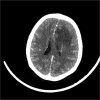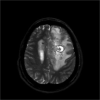Listeria monocytogenes meningoencephalitis in a patient with Systemic Lupus Erythematosus
- PMID: 32406475
- PMCID: PMC7657045
- DOI: 10.1590/2175-8239-JBN-2019-0212
Listeria monocytogenes meningoencephalitis in a patient with Systemic Lupus Erythematosus
Abstract
Introduction: Infectious complications are common in systemic lupus erythematosus. Although uncommon, central nervous system infections do occur and have significant lethality, with several etiological agents.
Methods: We report on the case of a 29-year-old woman recently diagnosed with systemic lupus erythematosus with hematological, cutaneous, serous and renal manifestations (class IV lupus nephritis), who underwent corticosteroid pulse therapy and mycophenolate induction therapy. After 3 months of evolution, she developed headache and altered mental status. Computed tomography showed an area of hypoattenuation in the left frontal white matter and her cerebrospinal fluid examination showed pleocytosis and hyperproteinorrhachia. Peripheral blood and CSF culture identified Listeria monocytogenes. The patient presented deterioration of her neurological status, requiring invasive mechanical ventilation, monitoring of intracranial pressure and, despite all the intensive support, persisted in a comatose state and developed multiple organ failure, evolving to death due to nosocomial bloodstream infection.
Discussion: Infection from L. monocytogenes usually occurs after eating contaminated food, manifesting itself with diarrhea and, occasionally, invasively, such as neurolisteriosis. Further investigation with CSF analysis and MRI is necessary, and the diagnosis consists of isolating the bacteria in sterile body fluid.
Conclusion: The case presents a patient whose diagnosis of meningoencephalitis became an important differential with neuropsychiatric disorder. The poor outcome reinforces the need to remember this infectious condition as a serious complication in the natural history of SLE.
Introdução:: As complicações infecciosas são frequentes no lúpus eritematoso sistêmico. Apesar de incomum, infecções do sistema nervoso central ocorrem e têm significativa letalidade, apresentando diversos agentes etiológicos.
Métodos:: Descrevemos aqui o caso de uma mulher de 29 anos recentemente diagnosticada com lúpus eritematoso sistêmico com manifestações hematológica, cutânea, serosa e renal (nefrite lúpica classe IV), submetida a pulsoterapia com corticoide e terapia de indução com micofenolato. Após 3 meses de evolução, apresentou quadro de cefaleia e alteração de estado mental. Tomografia computadorizada evidenciou área de hipoatenuação em substância branca frontal esquerda e exame de líquido cefalorraquidiano mostrava pleocitose e hiperproteinorraquia. Cultura de sangue periférico e do liquor identificaram Listeria monocytogenes. Paciente apresentou deterioração do quadro neurológico, necessitando de ventilação mecânica invasiva, monitorização de pressão intracraniana e, apesar de todo o suporte intensivo, persistiu em estado comatoso e disfunção de múltiplos órgãos, evoluindo a óbito por infecção de corrente sanguínea nosocomial.
Discussão:: Infecção por L. monocytogenes ocorre geralmente após ingestão de alimentos contaminados, manifestando-se por diarreia e, eventualmente, de forma invasiva como a neurolisteriose. Investigação complementar com análise de liquor e ressonância magnética faz-se necessária, sendo o diagnóstico confirmado por isolamento da bactéria em líquido corporal estéril.
Conclusão:: O caso representa uma paciente cujo diagnóstico de meningoencefalite tornou-se importante diferencial com atividade de doença neuropsiquiátrica. A evolução insatisfatória reforça a necessidade de se lembrar desta condição infecciosa como complicação grave na história natural do LES.
Conflict of interest statement
The authors declare that they have no conflicts of interest related to the publication of this manuscript.
Figures


Similar articles
-
A rare case of meningoencephalitis by Listeria monocytogenes in systemic lupus erythematosus: case report and review.Clin Rheumatol. 2018 Jan;37(1):271-275. doi: 10.1007/s10067-017-3783-6. Epub 2017 Aug 7. Clin Rheumatol. 2018. PMID: 28785856 Review.
-
Systemic lupus erythematosus (SLE) cerebritis versus Listeria monocytogenes meningoencephalitis in a patient with systemic lupus erythematosus on chronic corticosteroid therapy: the diagnostic importance of cerebrospinal fluid (CSF) of lactic acid levels.Heart Lung. 2012 Jul-Aug;41(4):394-7. doi: 10.1016/j.hrtlng.2011.09.002. Epub 2011 Dec 15. Heart Lung. 2012. PMID: 22177759
-
Central nervous system infection by Listeria monocytogenes in patients with systemic lupus erythematosus: analysis of 26 cases, including the report of a new case.Reumatol Clin. 2013 Nov-Dec;9(6):340-7. doi: 10.1016/j.reuma.2013.04.011. Epub 2013 Oct 2. Reumatol Clin. 2013. PMID: 24094430 Review. English, Spanish.
-
Systemic Lupus Erythematosus Complicated with Listeria Monocytogenes Infection in a Pregnant Woman.Intern Med. 2021 May 15;60(10):1627-1630. doi: 10.2169/internalmedicine.5079-20. Epub 2020 Dec 15. Intern Med. 2021. PMID: 33328397 Free PMC article.
-
Multiple brain abscesses due to Listeria monocytogenes infection in a patient with systemic lupus erythematosus: A case report and literature review.Int J Rheum Dis. 2021 Nov;24(11):1427-1439. doi: 10.1111/1756-185X.14226. Epub 2021 Oct 11. Int J Rheum Dis. 2021. PMID: 34633142 Review.
Cited by
-
Treatment failure in a patient infected with Listeria sepsis combined with latent meningitis: A case report.World J Clin Cases. 2022 Oct 16;10(29):10565-10574. doi: 10.12998/wjcc.v10.i29.10565. World J Clin Cases. 2022. PMID: 36312510 Free PMC article.
-
Basic Analysis of the Cerebrospinal Fluid: An Important Framework for Laboratory Diagnostics of the Impairment of the Central Nervous System.Curr Issues Mol Biol. 2022 Aug 14;44(8):3666-3680. doi: 10.3390/cimb44080251. Curr Issues Mol Biol. 2022. PMID: 36005147 Free PMC article.
-
Imaging modalities in neurolisteriosis: a literature review.Pol J Radiol. 2024 Jul 19;89:e345-e357. doi: 10.5114/pjr/189214. eCollection 2024. Pol J Radiol. 2024. PMID: 39139260 Free PMC article. Review.
References
-
- Skare TL. Reumatologia: princípios e prática. 2ª ed. Rio de Janeiro: Guanabara Koogan; 2007.
-
- Cuchacovich R, Gedalia A. Pathophysiology and clinical spectrum of infections in systemic lupus erythematosus. Rheum Dis Clin North Am. 2009 Feb;35(1):75–93. - PubMed
-
- Navarra SV, Leynes MS. Infections in systemic lupus erythematosus. Lupus. 2010 Oct;19(12):1419–1424. - PubMed
-
- Danza A, Ruiz-Irastorza G. Infection risk in systemic lupus erythematosus patients: susceptibility factors and preventive strategies. Lupus. 2013 Oct;22(12):1286–1294. - PubMed
Publication types
MeSH terms
Substances
LinkOut - more resources
Full Text Sources
Medical

